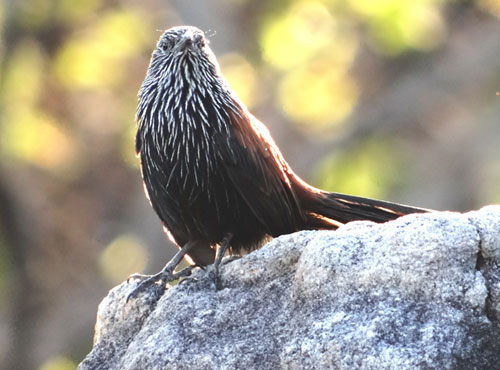Photos with this report (click to enlarge) | |||
 Black Grasswren |
|||
The primary aim of this trip with Alexander Watson was to see the Black Grasswren, one of the most difficult Australian endemics to snare because of the remote, difficult-to-access area in which the bird lives – the sandstone escarpments of the West Kimberley. Our itinerary was as follows:
June 16 – We departed Broome in our well-stocked 4-wheel drive at 6am, heading towards Derby and then eastwards along the Gibb River Road, turning north at its junction with the Kalumburu Road. We arrived late-afternoon at Drysdale River Station, where we camped the night.
June 17 – Early morning birding around the station before heading north, leaving the Kalumburu Road to head west to Mitchell River National Park. The road as far as the junction was not as bad as we expected; the last 88 kilometres were rougher and with deeper stream crossings, though easily manageable with care. We arrived around lunch-time, birding a little in the late afternoon; overnight in the busy park camp-ground.
June 18 – Early morning saw us at a site given to us for the Black Grasswren not far from Little Mertens Falls – further details here, along with photographs - http://sunshinecoastbirds.blogspot.com.au/2012/06/black-grasswren-at-mitchell-river.html. It took us less than hour to find an obliging pair, with Alexander spotting the first. We followed the birds for some time, watching them forage for insects in tangles of dead wood around the base of large boulders. Soon after, about 300 metres away, we found a second pair. We also found Kimberley Honeyeater, another target as it has been split from the White-lined Honeyeater of Arnhem Land.
We found we had to move camp because of the appalling, day-long noise made by commercial helicopters landing and departing. Later we were to lodge complaints with the Western Australian authorities about the manner in which they allow the serenity and majesty of this beautiful place to be undermined by commercial interests. In the afternoon we birded around park tracks; overnight in the camp-ground.
June 19 – In the morning we did the 4.5-kilometre walk to the stunning Mitchell Falls, passing Little Mertens and Big Mertens Falls on the way. We found another target, the Buff-sided Robin, below Little Mertens and along the track in a forest patch between those falls and Big Mertens. In the afternoon, I returned to our grasswrens while Alexander birded the newly created River View Trail, where he found a group of 4 Black Grasswrens. In both areas, the grasswrens often associated with Red-backed or Variegated Fairy-wrens. Although we had no trouble seeing the birds, they are not guaranteed; another birder we met had searched unsuccessfully for three days. Overnight in the camp-ground.
June 20 – We returned to the River View Trail early in the morning where the group of 4 grasswrens were easily found again. Late-morning we headed east again, retracing our steps and heading back south along the Kalumburu Road to Miner’s Pool, a lovely site on the Drysdale River a few kilometres north of the station where we spent our first night. Camp at Miner’s Pool.
June 21 – General birding around Miner’s Pool, the highlight being Lilac-crowned Fairy-wren in Pandanus patches along the river. Overnight Miner’s Pool
June 22 – We continued south to the Gibb River Road, then west to a little beyond Imintji, where we headed north 20 kilometres to the unpleasantly overcrowded, inaptly named Silent Grove camping ground (a big contrast after the peaceful Miner’s Pool) arriving there late-afternoon.
June 23 – Early morning drive to the scenic Bell’s Gorge, with birding later in the morning along the road between Silent Grove and the gorge. We left late-morning and arrived back in Broome late that afternoon. We carried extra water and fuel on this trip but did not need them.
June 25 – With Bill Watson, a few hours were spent in the mangroves behind Broome’s Central Business District. This proved productive with several good species seen, here at the south-western extremity of their range.
Little Pied Cormorant, Black-necked Stork (1 Miner’s Pool), White-faced Heron,
Nankeen Night-Heron (2 Miner’s Pool), Great Egret, Spotted Harrier (several Gibb River Road),
Brown Goshawk (common), Collared Sparrowhawk (1 Mitchell River NP), Black Kite,
Black-breasted Buzzard (2 Gibb River Road), Wedge-tailed Eagle, Nankeen Kestrel, Brown Falcon,
Barking Owl (heard Mitchell River NP), Southern Boobook, Tawny Frogmouth (2 Mitchell River NP),
Peaceful Dove, Bar-shouldered Dove, Diamond Dove,
Torresian Imperial-Pigeon (2 Mitchell River NP),
White-quilled Rock-Pigeon (fairly common Mitchell River NP),
Partridge Pigeon (race blaauwi - small numbers feeding around Mitchell River NP camp-ground),
Red-tailed Black Cockatoo, Galah, Sulphur-crested Cockatoo, Little Corella,
Rainbow (Red-collared) Lorikeet, Varied Lorikeet (uncommon but widespread),
Red-winged Parrot, Northern Rosella (2 Silent Grove), Pheasant-Coucal, Brush Cuckoo,
Blue-winged Kookaburra, Sacred Kingfisher, Rainbow Bee-eater, Welcome Swallow, Tree Martin, Fairy Martin, Great Bowerbird (common),
Lilac-crowned Fairy-wren (several parties heard, seen well at one site, Miner’s Pool),
Red-backed Fairy-wren, Variegated Fairy-wren,
*Black Grasswren (a total of 8 birds seen at 3 sites, Mitchell River NP),
Green-backed Gerygone (small numbers Mitchell River NP),
Dusky Gerygone (common Broome mangroves), White-throated Gerygone,
Weebill, Striated Pardalote,
*Kimberley Honeyeater (a total of 6 birds, Mitchell River NP),
White-gaped Honeyeater, Singing Honeyeater, Yellow-tinted Honeyeater, Blue-faced Honeyeater,
White-rumped Miner, Black-chinned (Golden-backed) Honeyeater (common Miner’s Hole),
Red-headed Honeyeater (common Broome mangroves), Banded Honeyeater (common),
Bar-breasted Honeyeater (common), Rufous-throated Honeyeater, Brown Honeyeater,
Little Friarbird, Silver-crowned Friarbird, Grey-crowned Babbler, Varied Sitella,
Black-faced Cuckoo-shrike, White-bellied Cuckoo-shrike, White-winged Triller,
Mangrove Golden Whistler (3 males seen separately in Broome mangroves),
Rufous Whistler, Grey Shrike-thrush, Sandstone Shrike-thrush (2 Mitchell River NP),
*Buff-sided Robin (a total of 3 along track to Mitchell Falls),
Little Woodswallow (common), Silver-backed Butcherbird, Pied Butcherbird,
Torresian Crow, Mudlark, Willie Wagtail, Mangrove Fantail (several Broome mangroves),
Northern Fantail, Restless Flycatcher (common), Leaden Flycatcher,
Broad-billed Flycatcher (a total of 4, Broome mangroves), Jacky Winter,
Rufous Songlark, Australasian Pipit, Yellow White-eye (common Broome mangroves),
Mistletoe-bird, Long-tailed Finch (common), Masked Finch (a few Gibb River Road),
Double-barred Finch, Crimson Finch.